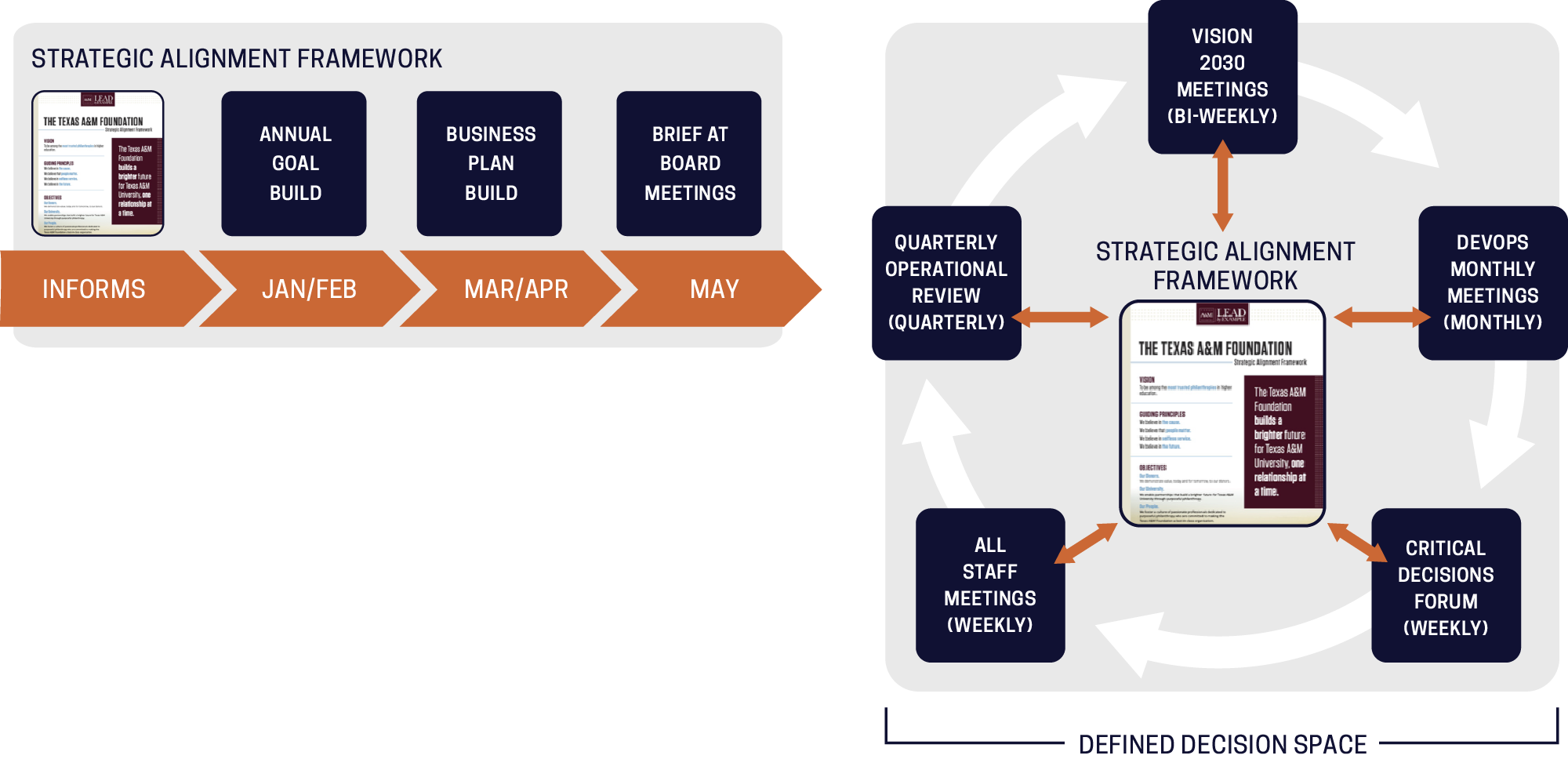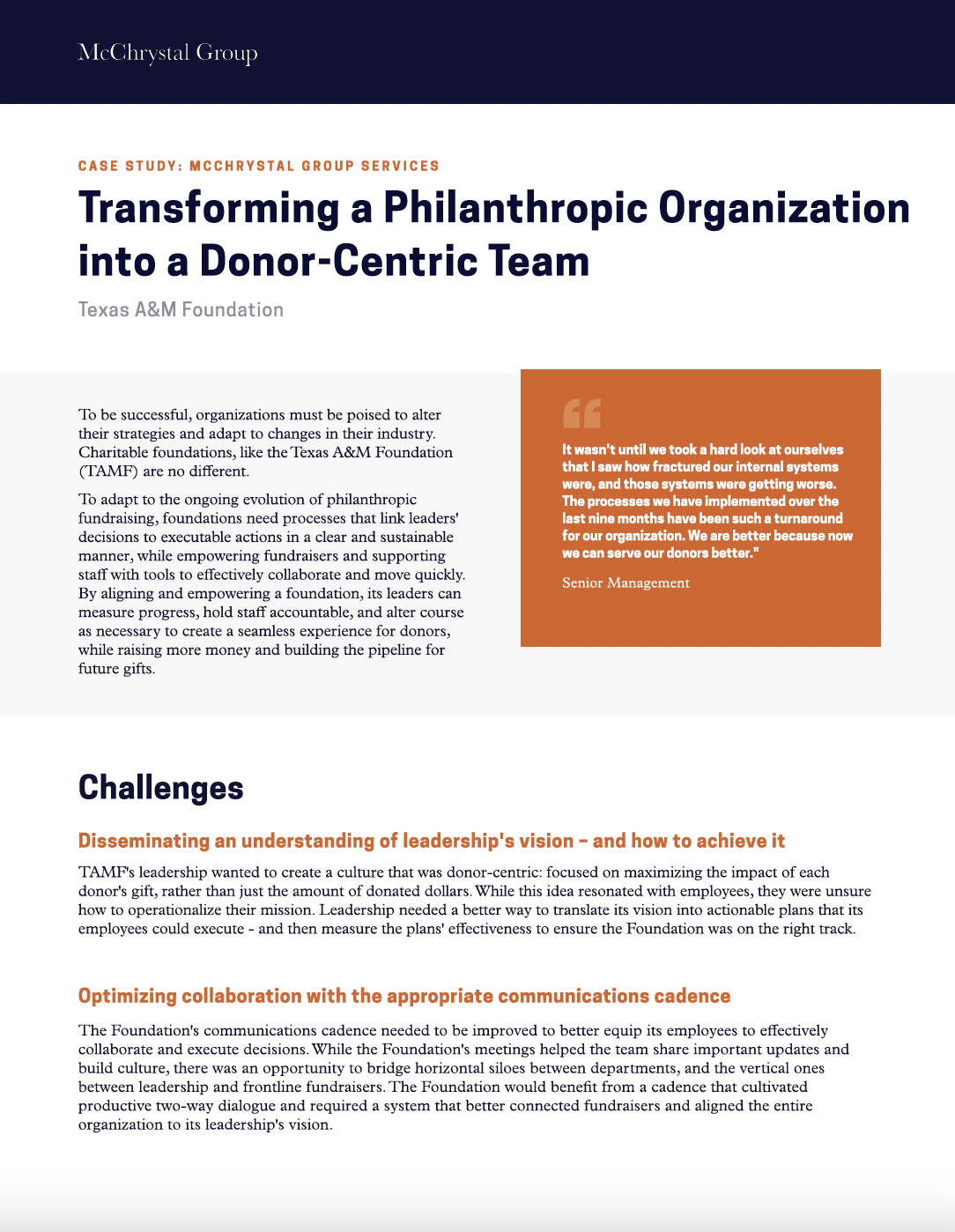McChrystal Group partnered with the Texas A&M Foundation (“the Foundation”) to create a culture in which the Foundation’s teams collaborate effectively to become donor-centric and optimize the impact of each gift, while stewarding the next generation of donors into the giving pipeline.
To be successful, organizations must be poised to alter their strategies and adapt to changes in their industry. Charitable foundations, like the Texas A&M Foundation (TAMF) are no different.
To adapt to the ongoing evolution of philanthropic fundraising, foundations need processes that link leaders’ decisions to executable actions in a clear and sustainable manner, while empowering fundraisers and supporting staff with tools to effectively collaborate and move quickly. By aligning and empowering a foundation, its leaders can measure progress, hold staff accountable, and alter course as necessary to create a seamless experience for donors, while raising more money and building the pipeline for future gifts.
Challenges
Disseminating an understanding of leadership’s vision – and how to achieve it
TAMF’s leadership wanted to create a culture that was donor-centric: focused on maximizing the impact of each donor’s gift, rather than just the amount of donated dollars. While this idea resonated with employees, they were unsure how to operationalize their mission. Leadership needed a better way to translate its vision into actionable plans that its employees could execute—and then measure the plans’ effectiveness to ensure the Foundation was on the right track.
Optimizing collaboration with the appropriate communications cadence
The Foundation’s communications cadence needed to be improved to better equip its employees to effectively collaborate and execute decisions. While the Foundation’s meetings helped the team share important updates and build culture, there was an opportunity to bridge horizontal siloes between departments, and the vertical ones between leadership and frontline fundraisers. The Foundation would benefit from a cadence that cultivated productive two-way dialogue and required a system that better connected fundraisers and aligned the entire organization to its leadership’s vision.
Streamline decision-making to increase empowerment
The existing operating cadence in the Foundation did not fully optimize decision-making throughout the organization. First and foremost, current processes created bottlenecks. Rather than feel empowered to execute quickly, fundraisers and supporting staff elevated decisions to leadership where they were delayed as they awaited approval. On the other hand, when leadership did make decisions, they did not have the proper channels to communicate the context and impact to necessary stakeholders.
Developing more effective leader behaviors within teams
To unleash the Foundation’s true potential and tackle the issues listed above, the Foundation needed to give direct attention to its employees and their development. The organizations history of silos and bottlenecks had created a suboptimal environment for employees to collaborate across functions and empower one another.
Solutions
Align the organization around a donor-centric vision
TAMF’s leadership cascaded the CEO’s vision into a framework of strategies that each employee could drive toward as part of their day-to-day work. Leadership assembled employees of varying functions and levels to build out the strategies—involving donors, the university, and employees—with innovative plans and measurable key performance indicators, enabling the entire Foundation to work towards the shared goal.
Improve leader performance through training
To ensure the success of newly developed processes, all levels of Foundation personnel participated in various interactive trainings and received coaching to improve their behaviors around sharing information, collaborating, innovating, delegating decisions, and having productive conflict.
Establish a communications cadence to connect employees and drive action
Foundation leaders redesigned the organization’s meetings cadence, reducing unproductive meetings and creating a series of new meetings with unique structures to promote (1) effective horizontal collaboration between fundraising units and support staff, and (2) better vertical collaboration between leadership and the rest of the organization. The team analyzed meetings and provided data-driven feedback to train meeting participants on communication methods that would drive follow-up actions.
Empower employees through clearly defined decision-making authorities
Alignment around the Foundation’s strategies and an improved communications cadence gave Foundation employees greater authority to make decisions. Managers defined decision authorities at each level with their reports, emphasizing the need to delegate decisions downward to the greatest extent possible. This clarity of decision authorities enabled all employees to have a greater understanding of where they fit in the organization, and empowered them to act. The Foundation is in a better position to unleash the full potential of its employees and maximize the impact of philanthropy on higher education.
Impact
The CEO of TAMF wanted to inculcate his organization’s Vision, Mission, and Objectives into the day-to-day lives of its employees. This alignment would provide more time for fundraisers to engage donors and require less time committed to leadership oversight. The chart below depicts how the Foundation operates today and displays the cadence that made this possible.
On the left-hand side of the chart is the Strategic Alignment Framework (SAF), the base for the Foundation's new operating architecture. The SAF drove the organization’s goals development process, which fed into the business plan development for each of the fundraising units. Each unit had its business plan nested in the same common purpose, ensuring intellectual alignment throughout the organization.

The right side of the chart depicts the operating rhythm the Foundation developed to cement this alignment. The Foundation built a meeting cadence that integrated the SAF, organizational goals, and business plans together to steer the Foundation toward becoming donor-centric. The new cadence tracked the progress of the SAF, measured the performance of fundraising units, and created an environment where all voices could be heard. This change in meeting execution expanded participation and productivity and caused meeting attendance to change from “required” to “desired.”
By creating a streamlined communication environment and delineating decision authorities at every level of the organization, the Foundation enhanced collaboration and increased accountability. The new understanding of where employees fit into the organization empowered teammates to execute against their goals, putting the Foundation in a better position to unleash the full potential of its employees.



